Honiara
Wednesday 10 May – Sunday 14 May 2000
When we arrived at Honiara’s
international airport, everyone seemed to be leaving.
A conflict between two ethnic groups on the main island of Guadalcanal
had been mounting and, as we discovered from our taxi driver, had culminated in
a death the day before our arrival. In an act of defiance towards their aggressors, the
victim’s killers had delivered a severed head to the main marketplace as a
warning they were not to be trifled with.
All this was news to us, but the
picture soon became clearer as we started to make enquiries with respect to
things we wanted to do whilst we were in the Solomon Islands.
People were beginning to panic and flights out of Honiara were booked
solid. Dive operators were doing
very little business around the main island, having been unable to take tourists
out of Honiara to other parts of the island for over 18 months.
Peace Corp volunteers were on alert to evacuate the country should the
situation deteriorate, and there was a general sense of unease about the town,
with groups of men gathering in the centre and several pairs of eyes
watching your every move.
Ironically, we discovered that
all the main hotels were full, so our thoughts soon moved from worry about civil
unrest to concern as to where we would find a bed for the next few nights. Thankfully we did and tired from our flight, after a
nondescript meal we headed straight for bed, deferring any continuing worries
until the following day.
In the light of day, things
didn’t appear to be a whole lot better. We
would be stuck in Honiara for at least four days, when the first seats on a
flight out of the capital would be available. The village-stays we had hoped to do would be impossible as
we couldn’t get flights to where we wanted to go, so we would have to fill our
time instead visiting island resorts with dive operators: not the best way to
get a taste of the real culture of the place, but at this point any hopes of a
Yap experience had long since evaporated. Looking
back, we remember wondering then whether we should simply call it quits and just
forget the whole thing, but being the persistent travellers we are, we were not
going to let a little unrest dissuade us from having a look around.
In the meantime, we had more
time to kill than we knew what to do with.
As the rest of Guadalcanal was officially off limits, there seemed little
more to do than walk around the capitol, visit the museum and check out the
local market, none of which were particularly inspiring. A closer inspection of the town also confirmed our initial
impressions of a run down, dusty, dirty place with very little charm.
Even the harbour area and wharf provided little respite from the motley
collection of shops and even smaller selection of restaurants on offer.
The guidebook, however, assured us that after a couple of weeks in the
provinces with no electricity, nowhere to eat out and (if you were lucky) a
one-shelf store, this meager town would suddenly undergo a magical
transformation and look as if it were a bustling and cosmopolitan metropolis,
which, if nothing else, certainly didn’t bode well for our outer-island
travels!
The saving grace (for Pippa),
however, was an internet connection at the hotel’s so-called business center,
in addition to which we managed to find a dive operator offering a weekend trip
to a small island off the northern coast of Guadalcanal where we could stay
overnight in a small, basic beach hut. Glad
of any alternative to another two days in the capitol, we leapt at the chance,
having been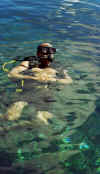 forewarned that places were limited and they would book up fast (no wonder,
given what little else there was to do around town).
forewarned that places were limited and they would book up fast (no wonder,
given what little else there was to do around town).
Despite its unfortunate name,
Fly Island turned out to be not only a welcome respite but an enjoyable one.
While the diving was unspectacular, it was nonetheless interesting and the
little resort, while basic, served excellent food and was in an idyllic,
tranquil location. Situated
smack-dab on the beach, the huts were shaded by coconut palms, there was cold
running water and the mosquito population was minimal.
This was a welcome relief for Pippa who was well aware that the Solomon
Islands has the highest rate of malaria in the world, with more than a third of
the population being infected each year and over half of all cases being on
Guadalcanal. As the ultimate
mosquito magnet, she was always trying to ward off these pesky visitors but
never more so than now she was pregnant.
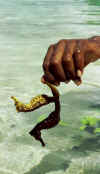 The highlight for both of us by far was our first-ever sighting of seahorses. The locals seemed surprised at our avid interest, presumably
used to finding them caught up in their fishing nets or bobbing in the weeds in
the shallows. But we delighted in
seeing these unusual and intriguing creatures in their natural habitat.
Another sight that brought smiles to our faces (and the cameras out of
our bags) were the young children frolicking in the water and paddling about in
the bay in canoes. Children barely seven or eight years old were deftly
maneuvering full-sized canoes around the small wooden pier
The highlight for both of us by far was our first-ever sighting of seahorses. The locals seemed surprised at our avid interest, presumably
used to finding them caught up in their fishing nets or bobbing in the weeds in
the shallows. But we delighted in
seeing these unusual and intriguing creatures in their natural habitat.
Another sight that brought smiles to our faces (and the cameras out of
our bags) were the young children frolicking in the water and paddling about in
the bay in canoes. Children barely seven or eight years old were deftly
maneuvering full-sized canoes around the small wooden pier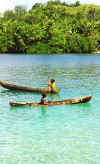 while their younger
siblings followed suit in their own miniature sized versions complete with
half-sized paddles.
while their younger
siblings followed suit in their own miniature sized versions complete with
half-sized paddles.
By the Sunday evening, we were
back in Honiara. Having
successfully managed to avoid all but a handful of mosquito bites, Pippa was now
covered from head to foot in huge red lumps caused by an allergic reaction to
something that was apparently abundant in the water.
But spirits were lifted as we finally flew out of Honiara the next day,
our destination a town called Munda on New Georgia Island in the Western
Province. As we sat in the domestic
terminal waiting for our flight, we noticed a few policemen patrolling the area
and began to wonder if we should feel a little more concerned about the current
situation.
Headhunter Harbor
Monday 15 May – Friday 19 May 2000
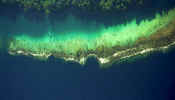 We
made it safely to Munda, which we expected to be a small town but was, in
fact, a collection of small villages stretching several miles along the coast.
All we were to see of it was the a tiny concrete shelter masquerading as
an airport terminal, and just behind it what appeared to be a hotel, as well the
only thing resembling a dive operation. After
arranging dives for the following day, we headed out across the lagoon by boat
to reach a tiny island where a fishing lodge we had read about in the Solomon
Airlines in-flight brochure was situated. Just as we were leaving, we bumped into Neil and Lyn Vincent,
a wonderful Australian couple who were both avid divers with a passion for
underwater cave exploration and photography.
Their list of prize-winning photographs puts our amateur holiday snaps to
shame, but we were to have several opportunities over the next few days to learn
more about underwater photography and to share in their captivating (albeit
costly!) obsession.
We
made it safely to Munda, which we expected to be a small town but was, in
fact, a collection of small villages stretching several miles along the coast.
All we were to see of it was the a tiny concrete shelter masquerading as
an airport terminal, and just behind it what appeared to be a hotel, as well the
only thing resembling a dive operation. After
arranging dives for the following day, we headed out across the lagoon by boat
to reach a tiny island where a fishing lodge we had read about in the Solomon
Airlines in-flight brochure was situated. Just as we were leaving, we bumped into Neil and Lyn Vincent,
a wonderful Australian couple who were both avid divers with a passion for
underwater cave exploration and photography.
Their list of prize-winning photographs puts our amateur holiday snaps to
shame, but we were to have several opportunities over the next few days to learn
more about underwater photography and to share in their captivating (albeit
costly!) obsession.
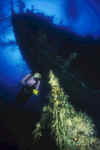
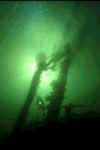
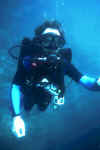
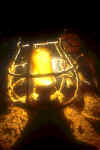
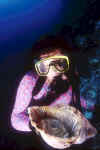
Lyn also proved to be Pippa’s
life-saver when she presented her with a hand-stitched lycra body suit to wear
in the water and protect her from whatever it was that had been stinging her.
The next day, fully protected from head to foot (literally), she joined
the divers on a trip out to Ndokendoke Island, where a fresh water pool in the
centre of the volcanic island leads via caves and caverns to a half-mile long
reef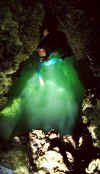 wall. The wall was alive with
corals and teeming with shoals of fish from small anemones to larger needle fish
and barracuda.
wall. The wall was alive with
corals and teeming with shoals of fish from small anemones to larger needle fish
and barracuda.
A day of diving with the only
(and less than professional) dive outfit available proved to be enough for Eric
so the remainder of our time was spent relaxing and enjoying the peace and
tranquility of Lola Island, where our lodge was situated.
The place was deserted, but for us; the owners explained they had
already had 75% of their bookings cancelled due to the troubles in Honiara.
We were certainly not complaining: the leaf house cottages were charming; there may have been no electricity
but there were cold water showers; the bar enjoyed a stunning vista over Vonavona lagoon, which was dotted with other small
islands and islets; the white coral sandy
beach was shaded by palm trees;
and snorkeling
just off the pier among the weeds was interesting, at least if you liked
sharks.
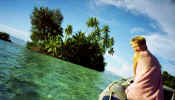 On
one of our laid-back and lazy days, we headed over to Skull Island.
This islet has a skull house or reliquary which contains the skulls of
many ancient chiefs dating from several hundred years ago up to the 1920's.
The island is nothing more than a speck of land jutting out of the water,
but is covered in thick vegetation and undergrowth. The skull house is a small and triangular-shaped casket and
as Nelson (our boatman-cum-guide) moved the
On
one of our laid-back and lazy days, we headed over to Skull Island.
This islet has a skull house or reliquary which contains the skulls of
many ancient chiefs dating from several hundred years ago up to the 1920's.
The island is nothing more than a speck of land jutting out of the water,
but is covered in thick vegetation and undergrowth. The skull house is a small and triangular-shaped casket and
as Nelson (our boatman-cum-guide) moved the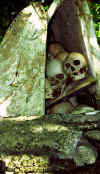 door to one side, we could see the skulls piled up inside together with shell
money and other valuables which presumably belonged to the chiefs.
The casket rested on a mound of coral which was also studded with skulls
(they were there to protect the chiefs, Nelson told us) and gave the whole place
a decidedly eerie feel.
door to one side, we could see the skulls piled up inside together with shell
money and other valuables which presumably belonged to the chiefs.
The casket rested on a mound of coral which was also studded with skulls
(they were there to protect the chiefs, Nelson told us) and gave the whole place
a decidedly eerie feel.
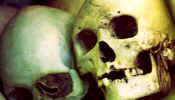 Thinking
about it, we weren't sure Nelson was telling us the whole story. We
remembered that this very lagoon was an infamous headhunter haven even into the
20th century. And some of the skulls didn't look all that old ... We looked
around for clues, but the skulls offered none: they just grimaced.
Shadows cast by the swaying palms danced across their bony features. It was all
a bit weird.
Thinking
about it, we weren't sure Nelson was telling us the whole story. We
remembered that this very lagoon was an infamous headhunter haven even into the
20th century. And some of the skulls didn't look all that old ... We looked
around for clues, but the skulls offered none: they just grimaced.
Shadows cast by the swaying palms danced across their bony features. It was all
a bit weird.
After our hasty departure from
Skull Island, we visited a small village
renowned for its weaving and had a chance to meet some local villagers in their
own environment and delve, albeit briefly, into some of their culture.
In all our time in the Solomons, we barely felt we had even scratched the
surface of the place. Within the
islands of Vonavona lagoon alone there was a staggering cultural diversity.
Pointing to a few islands just across from the lodge, Lisa, a local islander
who ran our hotel, explained that each of them had different languages and
customs, and the people who were born there considered themselves to be very
much descendents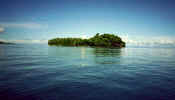 of their island rather than a Solomon Islander or even, for that matter, someone
from the Western Province. We had
not realised how common it was for people from villages only a mile apart to
speak mutually incomprehensible languages.
of their island rather than a Solomon Islander or even, for that matter, someone
from the Western Province. We had
not realised how common it was for people from villages only a mile apart to
speak mutually incomprehensible languages.
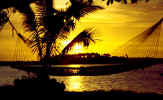 The
night before we left, there was a full moon.
The sky was clear and bright, littered with more stars than we had ever
remembered seeing. We could easily
make out the nearby islands within the lagoon and the water shimmered white in
the moon’s reflection. It was so
warm and peaceful that we decided to sit out on the small dock and enjoy the
moment. Everything was still. There
was the sound of the waves lapping gently upon the shore and up against the
sides of the boats but other than that, everything seemed motionless.
We looked up into the sky to see what constellations we could make out
and then, there it was: a shooting star.
And another one. And another
one. They seemed to be falling out of the sky every 10 to 15
minutes. Sometimes more often,
sometimes three or more in quick succession.
As if that hadn’t been magic enough, we then heard a long deep sigh out
in the water and realised what we had heard was a dugong.
Shy and majestic, these animals were known to frequent these waters but
were rarely seen. But on nights
such as these, they would come out to feed; the sigh was the sound of a dugong
catching his breath. It was hardly
a melodic sound, but it seemed so wistful and so rhythmic that it was endearing
and was to set us on a search to see a dugong before we finally left the
Pacific.
The
night before we left, there was a full moon.
The sky was clear and bright, littered with more stars than we had ever
remembered seeing. We could easily
make out the nearby islands within the lagoon and the water shimmered white in
the moon’s reflection. It was so
warm and peaceful that we decided to sit out on the small dock and enjoy the
moment. Everything was still. There
was the sound of the waves lapping gently upon the shore and up against the
sides of the boats but other than that, everything seemed motionless.
We looked up into the sky to see what constellations we could make out
and then, there it was: a shooting star.
And another one. And another
one. They seemed to be falling out of the sky every 10 to 15
minutes. Sometimes more often,
sometimes three or more in quick succession.
As if that hadn’t been magic enough, we then heard a long deep sigh out
in the water and realised what we had heard was a dugong.
Shy and majestic, these animals were known to frequent these waters but
were rarely seen. But on nights
such as these, they would come out to feed; the sigh was the sound of a dugong
catching his breath. It was hardly
a melodic sound, but it seemed so wistful and so rhythmic that it was endearing
and was to set us on a search to see a dugong before we finally left the
Pacific.
The next day, we were up at the
crack of dawn to fit in a half day of fishing before flying back to Honiara.
Our resort was a popular venue for serious fishermen and pictures of past
guests standing next to their catch of marlin were prominent throughout the bar
area. Enthused by these and her first fishing expedition in Yap,
Pippa decided another fishing trip was a must and so, as the sun was rising, we
were heading out towards the horizon to see what we could catch.
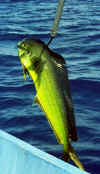 It
was a hot day but fun was had by all, not least Pippa, although sadly she
didn’t get a single bite on any of her lines.
Meanwhile, Eric was pulling them in thick and fast.
No marlin, but a beautiful rainbow runner, followed by a barracuda.
As we headed towards the second outpost, the telltale sign of birds
circling overhead raised our hopes and we changed lures to try our luck at
catching a few tuna. We could see
the commercial fishing boats out in the distance presumably reeling in yellowfin
bound for the Japanese market, but sushi was not to be on the menu for us.
Instead, we reeled in the most beautiful Mahi-Mahi (a fish Pippa had
never seen before) and another couple of rainbow runners before having to head
back to Lola island to collect our bags and head back out across the lagoon to
the airport.
It
was a hot day but fun was had by all, not least Pippa, although sadly she
didn’t get a single bite on any of her lines.
Meanwhile, Eric was pulling them in thick and fast.
No marlin, but a beautiful rainbow runner, followed by a barracuda.
As we headed towards the second outpost, the telltale sign of birds
circling overhead raised our hopes and we changed lures to try our luck at
catching a few tuna. We could see
the commercial fishing boats out in the distance presumably reeling in yellowfin
bound for the Japanese market, but sushi was not to be on the menu for us.
Instead, we reeled in the most beautiful Mahi-Mahi (a fish Pippa had
never seen before) and another couple of rainbow runners before having to head
back to Lola island to collect our bags and head back out across the lagoon to
the airport.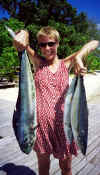
Our flight back to Honiara was
in a tiny 12-seater plane. Seeing
how small the plane was, we wondered if it would get off the ground, jam-packed
as it was with both passengers and luggage (to this day we have yet to see a
Pacific islander who can travel within his/her baggage allowance).
We had never flown in such a tiny plane but had total faith in our pilot
who gave a brief, informal safety briefing from his open cockpit area and then
repeated everything in Pijin (a form of English that is spoken by most
islanders), presumably to ensure all the locals who were flying with us had
understood how to use the emergency exits.
With that, he bowed his head and asked for us all to join him in prayer.
In all the hundreds of flights we have taken in our lifetimes, never had
we been asked to pray for a safe arrival at our destination.
We were definitely taken aback, suddenly wondering if he knew something
we didn’t. A hail and hearty
chorus of “Amen” arose from the passengers as the pilot ended his prayer and
almost simultaneously, people began to recheck their seat belts and pull out the
safety card in the seat pocket in front of them, just in case.
But we need not have worried.
Not only was our flight back safe, it was spectacular.
Flying above the open lagoons, looking down on the formations of island
clusters scattered across the expanse of blue and being able to make out the
coral reefs and drop-offs into deep water, was breathtaking.
And to top it off, we saw a volcano erupting out of the ocean, spewing
dark clouds of ash and smoke into the air and then disappearing once again
beneath the sea. If only we had had
more elbow room to get that perfect shot.
Pigeon, Coup
Saturday 20 May – Monday 22 May 2000
The dismal sight of the domestic terminal at Honiara
airport reminded us what we had returned to, but we reminded ourselves that we
were only going to be stopping overnight as we would be on another flight out
the next morning. Besides which, we
were meeting up with Neil and Lyn again for dinner, which we knew would be an
enjoyable way to spend the evening.
Our flight the next morning was
to Santa Cruz, in Temotu Province, the eastern-most part of the country.
From here, we were planning to head out to the Reef Islands, a five hour
boat ride further north in order to spend a few days on a remote outer island
called Pigeon Island. A trip so far east had not originally been part of our plan,
but Santa Cruz had proved to be one of the few places to which we could get a
flight; in addition, Pippa had come across Pigeon Island in the
guidebook and remembered an author by the name of Lucy Irvine or Irving who had
been out here for a while and written a series for the Sunday Times Magazine
about life on an island in the middle of nowhere.
Given that there was somewhere
we could stay on the island, we radioed ahead to advise them we were coming and
tried to find out what little we could about where we were going.
It gets little more than a few lines write up in the guidebook and given
that it is way off the beaten tourist trail, the tourist office had little to
offer us in terms of information. But,
this was not the first time we would be heading out into the unknown, so we were
actually looking forward to making the trip.
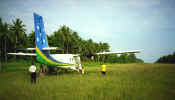 Despite the name, there are
apparently no pigeons on this tiny raised-coral atoll, just parrots and
plenty of them. The snorkeling
opportunities looked as if they would be spectacular given all the coral reefs
that were close by. But first, we
had to get there. The
plane standing out on the tarmac waiting to whisk us to Santa Cruz was slightly
bigger than the one the previous day, and despite the rain left on time.
Given the distance we would be flying, the pilot informed us that we
would be stopping en route to refuel and before long, came down to land on a
tiny grass airstrip on a remote island. While we stood
watching the locals wheel out the petrol drum and hand pump it into the tank, we
got talking to a Peace Corps volunteer who was stationed in Santa Cruz with her
husband. We got more insight into
what had been happening in Honiara and were amazed at the elaborate back up
strategies the Peace Corps had for evacuating their people should anything
happen.
Despite the name, there are
apparently no pigeons on this tiny raised-coral atoll, just parrots and
plenty of them. The snorkeling
opportunities looked as if they would be spectacular given all the coral reefs
that were close by. But first, we
had to get there. The
plane standing out on the tarmac waiting to whisk us to Santa Cruz was slightly
bigger than the one the previous day, and despite the rain left on time.
Given the distance we would be flying, the pilot informed us that we
would be stopping en route to refuel and before long, came down to land on a
tiny grass airstrip on a remote island. While we stood
watching the locals wheel out the petrol drum and hand pump it into the tank, we
got talking to a Peace Corps volunteer who was stationed in Santa Cruz with her
husband. We got more insight into
what had been happening in Honiara and were amazed at the elaborate back up
strategies the Peace Corps had for evacuating their people should anything
happen.
Before long, we were back up in
the air again and on the last leg of our journey, or so we thought.
After no more than maybe 10 minutes of flying, the pilot leant back to
tell us that he had radioed ahead to Santa Cruz and been told that the runway
was flooded and we would be unable to land.
He apologized for the inconvenience but informed us that he had no choice
but to turn around and return to Honiara. Unhappy at being back again so
soon, we spent an hour or two trying to figure out from the airline when they
would reschedule the flight. Rain
was forecast for the next two days so nobody had an answer, but it was finally
decided that it would leave on Monday (two days away) and in the meantime, we
would have to figure out our own accommodation etc.
All the hotels were once again
full but we returned to the one we had checked out of that morning and tried to
give a coherent explanation as to why we needed another room for an extra two
nights. Taking pity on us, they
found something for us and begrudgingly, we did another circuit of the town
looking to see if anything had changed since our last tour. It hadn’t.
The following day was Sunday and
the rain was still coming down. The
entry in Pippa’s diary for the day pretty much sums up how we were feeling:
“Rain, rain, rain. Woke up to
rain and spent all day looking at it. Walked
to museum but closed. Business
centre closed so no e-mail. Read,
wrote postcards. Bored.
Eric tetchy… wasting time.”
Monday morning dawned and under
yet more rain clouds, we retraced our steps to the airport, rechecked our
baggage and re-boarded a similar sized plane.
We took off, landed to refuel, watched the petrol drum being rolled out
once more and soon enough were back in the sky. After 10 minutes, we all began to breathe easier.
No problems with the runway at their end; we should be fine.
After half an hour or so, things began to get bumpy.
We were in thick cloud and visibility was zero.
But then, we’d been through worse so knew we’d be fine.
The pilot leant back to tell us he was going to turn back and see if he
could find a way around the storm (rather than through it which was our current
trajectory), advising that this may delay us a little but we’d still have
plenty of fuel to get us there. After
another 10 minutes, he informed us he obviously hadn’t gone far enough around
as we were still in the thick of it so he would try again.
By now, we were all beginning to
wonder if we would ever make it. After
a third attempt to circle the storm, we were running low on fuel and the pilot
decided to turn around and head back for Honiara. We landed at the refueling
stop once again and now for the third time watched the petrol drum being
rolled out. This slow, laborious
hand pump lark was now proving to be positively annoying rather than quaint,
standing as we were in the pouring rain willing for them to finish so we could
get back on the plane. As we
reached Honiara, everyone’s spirits were low.
Faced with the prospect of another two days in Honiara waiting for the
weather to clear and thereby leaving us only a day on Pigeon Island (should we
ever get there) we started making enquiries as to how frequent the flights to
our next destination, Port Vila (Vanuatu) were. There was a flight the next day.
Within minutes, we were booked on it.
Two weeks after leaving the
country, we learned that Malaitans on Guadalcanal had staged a coup.
The Peace Corps was evacuated, international air service to the Solomons was
suspended, and law and order in the capital was deteriorating. A lengthy
visit to Pigeon Island could have landed us in the thick of things, probably
quite safe but seriously inconvenienced. We had cut our losses, and
counted ourselves lucky.